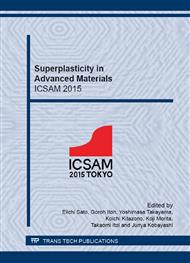p.225
p.231
p.237
p.243
p.249
p.256
p.261
p.267
p.272
Influence of Second-Phase Particles on the Hot Ductility of Al–Mg Solid-Solution Alloys
Abstract:
Class-I or Class-A solid solutions are substitutional with a relatively large difference in size between the solute and solvent atoms. High-temperature deformation of these solid solutions causes uniform transgranular deformation because of the solute drag motion of dislocations. Consequently, enhanced ductility can be obtained regardless of grain size. In our research, we specifically investigated the effects of second-phase particles resulting from adding impurity atoms on the hot ductility; i.e., how the second-phase particles obstruct the solute drag motion of dislocations. In this study, the effect of Mn and Cr impurities on the high-temperature ductility of typical Class-I Al−Mg solid solutions is investigated. The results show that hot ductility in the basic Al−Mg alloy leads to an elongation to fracture of above 200% at 673 and 723 K. We found that the dominant deformation mechanism causing high ductility is solute drag creep. The hot ductility decreases when Cr is added to the basic alloy, but an elongation to fracture of above 200% can still be achieved by adding Mn, although the elongation is less than that of the basic alloy.
Info:
Periodical:
Pages:
249-255
Citation:
Online since:
January 2016
Authors:
Price:
Сopyright:
© 2016 Trans Tech Publications Ltd. All Rights Reserved
Share:
Citation:


